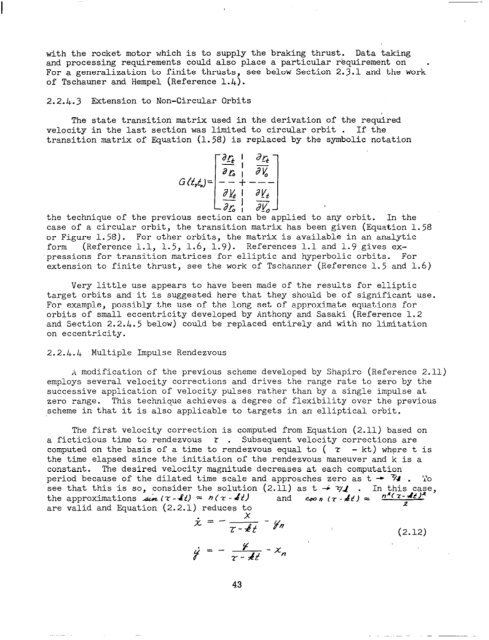guidance, flight mechanics and trajectory optimization
guidance, flight mechanics and trajectory optimization
guidance, flight mechanics and trajectory optimization
Create successful ePaper yourself
Turn your PDF publications into a flip-book with our unique Google optimized e-Paper software.
with the rocket motor which is to supply the braking thrust. Data taking<br />
<strong>and</strong> processing requirements could also place a particular requirement on .<br />
For a generalization to finite thrusts, see below Section 2.3.1 <strong>and</strong> the work<br />
of Tschauner <strong>and</strong> Hempel (Reference 1.k).<br />
2.2.4.3 Extension to Non-Circular Orbits<br />
The state transition matrix used in the derivation of the required<br />
velocity in the last section was limited to circular orbit . If the<br />
transition .matrix of Equation (1.58) is replaced by the symbolic notation<br />
--pi $1 ,<br />
the technique of the previous section can be'applied to any orbit. In the<br />
case of a circular orbit, the transition matrix has been given (Equation 1.58<br />
or Figure 1.58). For other orbits, the matrix is available in an analytic<br />
form (Reference 1.1, 1.5, 1.6, 1.9). References 1.1 <strong>and</strong> 1.9 gives ex-<br />
'pressions for transition matrices for elliptic <strong>and</strong> hyperbolic orbits. For<br />
extension to finite thrust, see the work of Tschanner (Reference 1.5 <strong>and</strong> 1.6)<br />
Very little use appears to have been made of the results for elliptic<br />
target orbits <strong>and</strong> it is suggested here that they should be of significant use.<br />
For example, possibly the use of the long set of approximate equations for<br />
orbits of small eccentricity developed by Anthony <strong>and</strong> Sasaki (Reference 1.2<br />
<strong>and</strong> Section 2.2.4.5 below) could be replaced entirely <strong>and</strong> with no limitation<br />
on eccentricity.<br />
2.2.4.4. Multiple Impulse Rendezvous<br />
A modification of the previous scheme developed by Shapiro (Reference 2.11)<br />
employs several velocity corrections <strong>and</strong> drives the range rate to zero by the<br />
successive application of velocity pulses rather than by a single impulse at<br />
zero range. This technique achieves a degree of flexibility over the previous<br />
scheme in that it is also applicable to targets in an elliptical orbit.<br />
The first velocity correction is computed from Equation (2.11) based on<br />
a fictitious time to rendezvous r . Subsequent velocity corrections are<br />
computed on the basis of a time to rendezvous equal to ( f - kt) where t is<br />
the time elapsed since the initiation of the .rendezvous'maneuver <strong>and</strong> k is a<br />
constant. The desired velocity magnitude decreases at each computation<br />
period because of the dilated<br />
see that this is so, consider<br />
the approximations &ir-g~!)<br />
are valid <strong>and</strong> Equation (2.2.1)<br />
time scale <strong>and</strong> approaches zero as t --c 74 .<br />
the solution (2.11) as t -G T/J . Inn $$-$y,<br />
c fi(-r-dt) <strong>and</strong> Eaon (-r-At) =<br />
reduces to<br />
2<br />
"<br />
‘20<br />
43
















